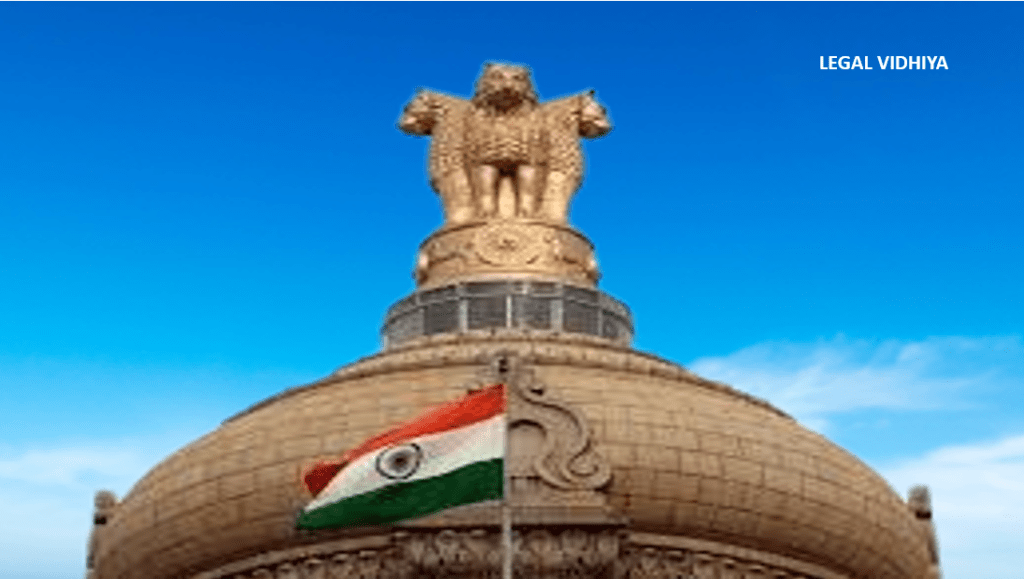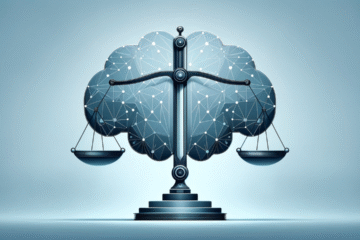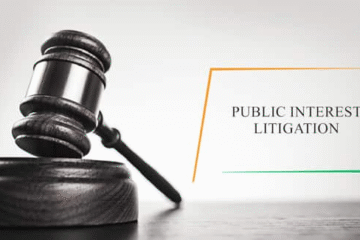
This article is written by Gargi Mishra of 3rd Semester of Symbiosis Law School, NOIDA, an intern under Legal Vidiya.
ABSTRACT
“India, the world’s largest democracy, boasts the world’s longest constitution, with 448 Articles divided into 25 Parts and 12 Schedules, and it breathes the air of sovereignty.”[1] A notable place in Indian history is given to the narrative that led to the creation of the Indian Constitution. The Indian Constitution origin encompass a diverse range of inspirations, including historical documents, foreign constitutions, and indigenous traditions. Key influences include the “Government of India Act of 1935,” which provided a blueprint for federalism and administrative structure, and constitutions of many different countries providing different features like fundamental rights, duties, DPSPs, etc. Additionally, ancient Indian legal texts such as the Manusmriti and the Arthashastra, along with principles from the Indian Independence Movement, have been incorporated into the constitutional framework.
The structuring of the Indian Constitution was a monumental task undertaken by the Constituent Assembly, composed of elected members from diverse backgrounds, regions, and ideologies. The assembly meticulously debated and deliberated upon various aspects, leading to the adoption of a comprehensive document on January 26, 1950. The Constituent Assembly played a crucial role in synthesizing these diverse influences into a cohesive and forward-looking constitution.
Keywords: Rule of law, Provincial Autonomy, Federal legislature, Parliamentary System Of Government, Writs, Judicial Review, Constituent Assembly, Objective Resolution, Preamble.
OBJECTIVES
This article aims at finding the different sources of the Indian constitution and to understand the importance of their inclusion in the constitution while it aims to outline the historical background and role of constituent assembly for framing Indian constitution. It tries to give light on all the events and people involved in this whole formation of this Indian rule book.
INTRODUCTION
The nearly two-century-long movement for Indian independence went through various stages with varying demands. Having numerous obstacles and half-hearted attempts by the colonial authorities, every demand was satisfied, from involvement in the legislative assembly to dominion status towards complete independence. Moreover, in the 20th century, the demand for an Indian Constituent Assembly embraced the national movement and was ultimately successful after a two-decade battle.
“The Assembly spent the years 1946 to 1950 drafting the legal framework of democratic India, which was finally approved on November 26, 1949, taking effect on January 26, 1950, which has since become India’s Republic Day. To draft the Indian Constitution, the Constituent Assembly has precisely taken 2 years, 11 months, and 17 days to do so and a total expenditure of Rs 6.4 million to finish. The Assembly met for eleven sessions for a total of 165 days during this time, 114 of which were devoted to debating the draft constitution.” [2]
In this process, Indian lawmakers has taken different aspects from constitutions of various different countries and with whole procedure framed the Indian Constitution. This article puts light on the sources and the framing of the constitution which is discussed below.
SOURCES OF INDIAN CONSTITUTION
The main aim of the Indian constitution is that people in India can be sure they will reside in a society that is fair and free. To accomplish this the Constitution was influenced by a number of sources. The provisions of several pieces of legislation were included while bearing in mind the requirements and condition of India, including the “Government of India Act of 1858, the Indian Councils Acts of 1861, 1892, and 1909, the Government of India Acts of 1919 and 1935, and the Indian Independence Act of 1947” while many other provisions were taken from the various countries like America, Britain, Ireland, etc.
Government Of India Act, 1935
The “Government of India Act of 1935” left a legacy that was finished by the Constitution of 1950. With 321 sections and 10 schedules, this was the British government’s longest act. This was the major source of Indian Constitution. Provisions taken from this act are:
Constitution borrowed the feature that a Governor should be appointed in every state which would be elected by the central government.
Federal Legislature- The act implied that the legislative would consist of two houses, the “Federal Assembly,” and the “Council of States.” The upper house, the Council of States, was a definite body with a three-year term. Another was the Federal Assembly which served as the lower house, with terms extending up to five years. After Independence, the Parliament became the legislative union with two houses came to known as Lok Sabha and Rajya Sabha.
Provincial Autonomy- This law gave provincial governments the freedom from outside interference and control by requiring them to answer exclusively to their own provincial legislatures. The adoption of this act resulted in the division of powers between the federal government and the provinces into three lists: the “Federal list” to which the central power makes laws, the “Provincial list” to which the state government make laws, and the “Concurrent list” for which both the center and state can make laws. This autonomy exists after independence as well.
The provision of emergency and Public Service Commission are also taken from this act.
The United Kingdom
Parliamentary Government- An elected group of ministers headed by the prime minister governs the nation under a parliamentary system of government. The Prime Minister is the elected leader of the government, while the President, is the commander in chief of the state. The existence of multiple opposing parties that exist to hold the ruling party and its operations in check is the primary characteristic of the parliamentary system of government.
Rule of Law- This concept says that a State is controlled by its own laws, not by its representatives or its citizens. According to the concept of the rule of law, everyone is on an equal footing with the law, including those who enact it. The rule of law is formally codified in Article 14 (Right To Equality) of the Indian Constitution.
Single Citizenship- A person who was born or immigrated to Indian Territory is said to have a single citizenship, which suggests that they can only exercise their civil and political rights in India and not in another nation while holding one citizenship. India does not permit dual citizenship as a result.
Writs- “The Right to Constitutional Remedies [Articles 32 to 35] is available to citizens in India because of the Supreme Court and High Courts’ authority to issue writs. There are five writs: Habeas Corpus (present the detained person before the court and release him if detention is determined to be illegal), Mandamus (a command from the Supreme Court or the High Court to a tribunal or lower court to fulfill a public duty), Certiorari (the SC or HC issues the writ to overturn the decision already made by a lower court), Prohibition (issued by the SC or the HC to an individual to prevent the latter from holding public office which he is not entitled). Article 32 and 226 of the Constitution provide these writs.”[3]
Speaker’s position in context and his function, legislative processes, law’s established procedure are also taken from U.K constitution.
The United States Of America
Fundamental Rights- All of the fundamental rights are outlined in Articles 12 through 32 of the Constitution. The fundamental human rights accorded to the citizens to ensure their equality before the law. “The six fundamental rights are: the right to equality (Article 14), the right to freedom from exploitation (Article 23 & 24), the right to religious freedom (Article 19), the right to cultural and educational rights (Article 29 & 30), and the right to constitutional relief (Article 32 to 35 & 226).”[4]
Judicial Review: The Judicial Review clause favors the judiciary in its interpretation of the Constitution. Thus, if a legislative or executive order conflicts with the nation’s Constitution, the judiciary may annul that order.
President Impeachment and Judge Removal: Article 61 of the Constitution allows for the President to be removed through parliamentary processes conducted by both houses of Parliament. Judge dismissal is covered by Article 124(4) of the Constitution and the “Judges Inquiry Act of 1968.”
Preamble, the three pillars of government being independent and autonomous, the Electoral College, the President serving as the supreme commander of the Armed Forces, and equal protection under the law are other some provisions taken from U.S constitution.
France
The ideas of “Liberty, Equality, and Fraternity” in the Indian Preamble were taken from the French Constitution. In the tradition of the French Constitution, the Indian state eventually gained recognition as the “Republic of India.”
Ireland
The “Directive Principles of State Policy (DPSP)” clause is the primary aspect of the Irish Constitution that has been adopted. The DPSP are established in Part IV of the Constitution, making it crystal clear that it is the State’s duty to put these principles into practice while passing legislation. Socialist directions, Gandhian directives, and liberal philosophical guidelines are the main divisions that may be made between these ideas. Ireland is also used as a model for India’s Rajya Sabha nomination process.
Canada
The clauses of a “Federation with a strong center,” the remaining powers of the center, the center’s selection of state governors, and the supreme court’s advisory role have all been lifted from the Canadian constitution. According to Article 248 of the Constitution, only the Parliament has the authority to enact laws addressing any matter not covered by the Union or State lists. The Supreme Court is granted advisory authority under Article 143. According to this clause, the President may ask the Supreme Court for advice on subjects of public concern, and after carefully reviewing the case, the Supreme Court may then provide additional advice.
Australia
The regulations of “Freedom of Trade and Commerce inside the nation and between the states” are a gift from the Australian Constitution. The Indian Constitution’s Articles 301-307 include the relevant clauses. Additionally, Australia sent us the rules for the concurrent list and the results of their joint session of both chambers of parliament.
Germany
The German Constitution gave us a clause that allowed us to suspend fundamental rights in times of emergency. The South African Constitution also provided us with information on how Rajya Sabha members were chosen and methods of amendments.
Russia
Fundamental duties and Idea of “Social, Economic, and Political Justice” in Preamble are taken from Russian constitution.
Weimar Republic
Fundamental rights are suspended in times of emergency are taken from this country.
South Africa
The South African Constitution also provided us with information on how Rajya Sabha members were chosen and methods of amendments.
Japan
Procedure established by law, Laws on which the Supreme Court functions are taken from Japan.
Framing of the Indian Constitution
In 1924-25, it was the first time when a constitution was demanded in a Round Table Conference which came to be known as “National Demand.” A committee led by Moti Lal Nehru was established in 1928 by consent of the All-Parties Conference to decide the fundamentals of the Indian constitution. The committee delivered the document that became known as the “Nehru Report.” The Nehru Report was significant because it provided the framework for India’s constitution. A parliamentary system of governance and India’s fundamental rights were envisioned in this report.
In 1930-32, Round table discussions on India’s constitutional formation were held. The British government realized that piecemeal solutions would not satisfy Indians’ ambition to draft their own constitution. M. N. Roy proposed an adult suffrage-based constituent assembly to draft the constitution in the years 1933–1934. With relation to the constitution and assembly, Pt. Jawaharlal Nehru said significant statement in 1938: “The constitution of free India must be framed, without outside interference, by a constituent assembly elected based on adult franchise.”
British consistently opposed the proposal laid for a constituent assembly. However, once World War 2 got underway, the British government began to give India concessions in an effort to get support in the war. In order to gain India’s help in the war effort, a series of proposals was made in 1940; these propositions became known as the “August Offer.” It was the first time that the right of Indians to draft their own constitution had been acknowledged. However, the majority of India’s political parties rejected this offer.
After that, in 1942, the “Cripps Mission” and in 1945, the “Wavell Plan” were proposed; however, both failed because of their nature to create a dominion status and the Muslim League’s demand for exclusive representation of Muslims.
The British government declared that it would dispatch a “Cabinet Mission” in February 1946 to address the problem of independence and constitution-making. The mission made the decision to establish a constituent assembly, whose members would be chosen by provincial legislative assembly delegates. 299 people were chosen from all communities and notable provinces to participate in the Constituent Assembly, which was charged with the historic function of drafting the constitution for an independent India. The Muslim, Sikh, and General committees each received seats according to the proportion of their respective populations.
On December 9, 1946, the Constituent Assembly, which had been chosen to represent undivided India, held its first meeting. On August 14, 1947, the Constituent Assembly reconvened as the solemn Constituent Assembly for the Dominion of India. The oldest member, Dr. Sachidanand Sinha became the provincial president and Dr. Rajendra Prasad as the permanent chairman.
Jawaharlal Nehru introduced the “Objective Resolution” at the assembly on December 13, 1946. It outlined the foundation and guiding principles of the constitutional framework. The assembly approved this resolution on January 22, 1947. The current constitution’s preamble is made up of its revised version.
“In the case of members from Indian States, the selection process was to be decided by consolation. A separate Constituent Assembly was established for Pakistan as an outcome of the Partition under the ‘June 3 Plan’ or ‘Mountbatten Plan’ in1947. A new election was held in the newly created provinces of West Bengal and East Punjab, and the representatives of Bengal, Punjab, Sind, North-Western Frontier Province, Baluchistan, and the Sylhet district of Assam (which had joined Pakistan by referendum) ceased to be members of the Constituent Assembly of India. Thus, the House had 299 members when the Constituent Assembly reconvened on October 31, 1947. On November 26, 1949, 284 of these people were actually present and signed the Constitution.”[5]
“13 committees were set up by the constituent assembly including the drafting committee. At its first meeting on August 30, the Drafting Committee (DC) chose Dr. Ambedkar as its chairman. The DC then met for 42 days, starting on October 27, 1947, to go over each section of initial draft. The DC gave the President of the Constituent Assembly a Revised Draft Constitution on February 21, 1948. It contained 8 schedules and 315 items. Ambedkar also thanked the Joint Secretary and Draftsman, Sir B N Rau, and Shri S N Mukherjee, in his covering letter. A special committee was established to work on next set of actions.”[6]
Major Committees of Constituent Assembly–
“Drafting Committee- presided by Dr. B. R. Ambedkar
Union Powers Committee- presided by Jawaharlal Nehru
Union Constitutional Committee- presided by Jawaharlal Nehru
Provincial Constitution Committee- presided by S. Patel
Advisory Committee on Fundamental Rights, Minorities and Tribal Excluded areas- presided by S. Patel. It had other sub-committees.”[7]
Minor Committees of Constituent Assembly–
“Committee on the functions of constituent assembly- presided by GV Mavlankar
Order of Business Committee- presided by Dr, K M Munshi
House Committee- presided by B Pratabhi Sitaramayya
Ad-hoc Committee on the National Flag- presided by Dr. Rajendra Prasad
Special Committee to examine the draft constitution- presided by Alladi Krishnaswami Ayyar”[8]
Important Members of Constituent Assembly–
“President of the Constituent Assembly- Dr. Rajendra Prasad
Provincial President- Dr. Sachidanand Sinha
Vice Presidents- VT Krishnamchari, Harendra Coomar Mookerji
Constitutional Advisor- Dr. B. N Rau
Chairman of Drafting Committee- Dr. B. R. Ambedkar (“Father of Indian Constitution”)
Secretary of Constituent Assembly- H.V.R Iyengar”[9]
“Prem Behari Narain Raizada served as the calligrapher for the Indian Constitution. He penned the original constitution by hand in flowing italics. Nand Lal Bose and Beohar Rammanohar Sinha, two Shantiniketan artisans, embellished and beautified the basic shape. The Hindi Translation was calligraphed by Vasant Krishna Vaidya and exquisitely decorated and lit by Nand Lal Bose.”[10]
In 1948, the Assembly acquainted the constitution’s final draft. On November 26, 1949, the assembly accepted an official constitution to the people of India by receiving signature of Dr. Rajendra Prasad. A few of the provisions became effective on the aforementioned date, but the majority became effective on January 26, 1950, which is the “date of commencement”. This day was selected to honor the “Purna Swaraj” movement, which began on the same day in 1930. These individuals, despite being a multiethnic group from many communities, were all devoted to finishing the historic mission of building a “Democratic Republic Of India.”
CONCLUSION
In conclusion, the Indian Constitution’s sources and framing reflect a rich tapestry of historical, cultural, and global influences. Its resilience and adaptability have allowed it to serve as a bedrock for Indian democracy, ensuring that the nation evolves while upholding its core principles of justice and inclusivity. Understanding the sources and framing of the Indian Constitution is essential to appreciate the unique and enduring character of India’s democratic system. The challenges and compromises faced during the framing process, including debates on federalism, secularism, and minority rights. The Indian Constitution emerged as a synthesis of various perspectives, emphasizing principles such as justice, liberty, equality, and fraternity, which continue to guide the nation’s governance and legal framework.
REFRENCES
- https://www.constitutionofindia.net/the-constitution-framers/ (last visited 10 September, 2023).
- https://byjus.com/free-ias-prep/evolution-and-framing-of-the-constitution/#:~:text=The%20Constitution%20of%20India%20was,Assembly%2C%20as%20the%20Provisional%20President. (last visited 10 September, 2023).
- https://www.legalserviceindia.com/legal/article-3061-framing-of-indian-constitution.html (last visited 10 September, 2023).
- https://en.wikipedia.org/wiki/Constitution_of_India (last visited 10 September, 2023).
- https://testbook.com/ias-preparation/major-committees-in-indian-constituent-assembly (last visited 10 September, 2023).
[1] Adda247, https://currentaffairs.adda247.com/how-many-articles-in-indian-constitution/#:~:text=Indian%20constitution%20has%20448%20articles,22%20parts%20and%208%20schedules. (last visited 10 September, 2023).
[2] BYJU’S, https://byjus.com/free-ias-prep/evolution-and-framing-of-the-constitution/#:~:text=The%20Constitution%20of%20India%20was,Assembly%2C%20as%20the%20Provisional%20President. (last visited on 10 September, 2023).
[3] Legal Services India, https://www.legalserviceindia.com/legal/article-9960-5-types-of-writs-in-indian-constitution.html#:~:text=Conclusion%3A,to%20perform%20under%20the%20law. (last visited on 10 September, 2023).
[4] Know India, https://knowindia.india.gov.in/profile/fundamental-rights.php#:~:text=Right%20to%20freedom%20of%20speech,order%2C%20decency%20or%20morality). (last visited on 10 September, 2023).
[5] BYJU’S, https://byjus.com/free-ias-prep/evolution-and-framing-of-the-constitution/#:~:text=The%20Constitution%20of%20India%20was,Assembly%2C%20as%20the%20Provisional%20President. (last visited 10 September, 2023).
[6] IPleaders, https://blog.ipleaders.in/making-constitution-india-detailed-analysis/ (last visited 10 September, 2023).
[7] Text Book, https://testbook.com/ias-preparation/major-committees-in-indian-constituent-assembly (last visited 10 September, 2023).
[8] Text Book, https://testbook.com/ias-preparation/major-committees-in-indian-constituent-assembly (last visited 10 September, 2023).
[9] Constitution Of India, https://www.constitutionofindia.net/the-constitution-framers/ (last visited 10 September, 2023).
[10] Hindustan Times, https://www.hindustantimes.com/india-news/constitution-was-the-first-canvas-of-modern-masters/story-xItSJivjhCeiloAblxJClN.html (last visited 10 September, 2023).




0 Comments